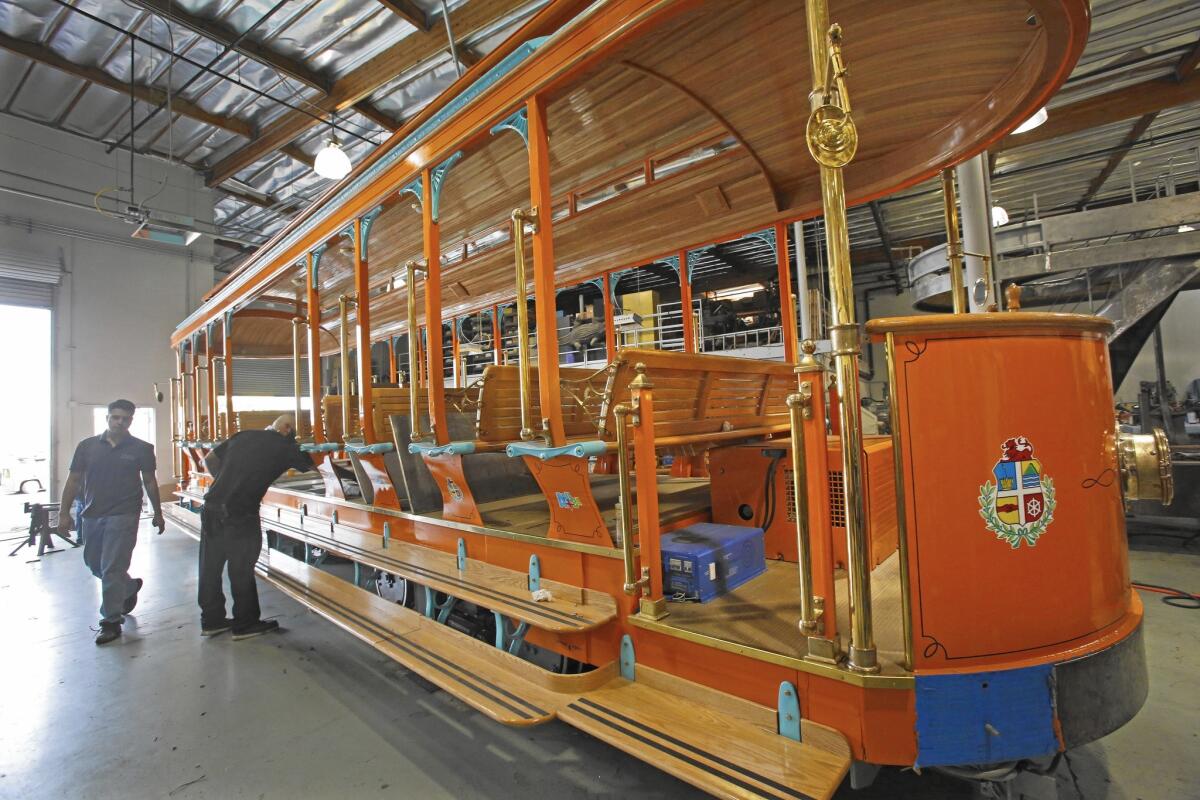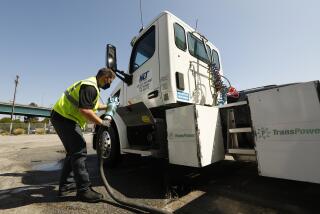Chatsworth trolley maker is going places

Chatsworth-based TIG/m Modern Street Railways makes trolleys that don’t need overhead wires and don’t pollute. So far, the trolleys mainly transport tourists in Aruba and the Middle East.
To manufacture an advanced rail streetcar, sometimes a chain saw is required.
The vintage-looking trolley cars produced at TIG/m Modern Street Railways are crammed with high-tech machinery and modern materials — except for the wheel system, which is cheaper to scavenge from old vehicles than to build from scratch. One source is a streetcar graveyard deep in a Pennsylvania forest.
“It’s like a jungle in there,” said TIG/m co-owner and President Brad Read, 61. “And when we go to buy them, the owner has to go in with a chain saw and cut down the trees just to get them out.”
This mixture of new and old is propelling the Chatsworth company into what co-owners Read and Alvaro Villa think is the future for transportation technology: streetcars that don’t need overhead wires and don’t pollute. So far, the trolleys mainly carry tourists in Aruba and the Middle East.
The partners think they have a solution for cash-poor municipalities in the U.S. — short streetcar loops to revitalize downtown cores.
“Our mission is to make it more affordable to reintroduce the electric streetcar in the United States,” Read said. “That is why we developed this technology.”
TIG/m’s owners say they can dramatically cut the costs on some projects because their streetcars don’t require an expensive system of overhead electric wires. The cars are powered by hydrogen fuel cells or banks of batteries, which can be recharged with solar power.
The cost of putting in track including an overhead wire is at least $10 million to $20 million a mile, depending on local costs, Read said.
“When we remove the overhead wire, all of the poles and substructure, all of the transformers and feeder stations to get electricity to the alignment, we reduce that cost by at least $5 million a mile,” Read said.
Moreover, Villa said, “no pollution is involved. No fossil fuels are used. It’s totally green.”
The company recently has landed projects in Dubai, Qatar and Aruba with the help of city officials and the Export-Import Bank.
As a result, the company’s workforce has risen to 35, and Read and Villa are looking for a factory twice the size of the current 25,000-square-foot plant.
Villa and Read, both engineers, were introduced more than 10 years ago by a mutual friend who knew their fascination with gadgetry.
Read was president of Transportation Innovations Group, which built the double-decker trolley that travels from the Grove shopping center to the Farmers Market next door.
The Grove trolley “was the prototype for everything we are doing here at TIG/m,” said Read, who grew up in Cleveland, where his father was a metallurgist and manager for Republic Steel.
Villa, 73, is from Colombia and an expert in robotics and animatronics who spent several years at Walt Disney Co. as an “imagineer.”
He went on to found his own company, AVG Inc., which specialized in audio-animatronic figures and amusement park rides.
Villa figures that one of his most complicated jobs was a $400,000 robotic Andy Warhol with enough hydraulic tubing and electronic actuators to mimic 54 human movements, including a shoulder shrug and a bobbing Adam’s apple. The show it was planned for never happened because the funding dried up, but the Warhol robot was bought by a private collector for an undisclosed sum.
“I was intrigued by what Read’s company was doing,” said Villa, who built the electric car he drove to work at Disney.
“Since I was very young,” Villa said, “I believed in this kind of electric vehicle technology. Our business has given me a chance to do something I’ve always wanted to do: design the best kind of electric transportation system that works with zero pollution.”
The company’s streetcars can operate without wires or an outside power source because they use onboard energy storage and regenerative braking, similar to that used in hybrid vehicles.
Its most sophisticated streetcars use hydrogen fuel cells as a power source.
In Aruba, two of TIG/m’s streetcars will run a short route from the cruise line docks to its capital and largest city, Oranjestad.
Last month, the company announced that it had delivered its first car in a contracted fleet of hydrogen/electric hybrid, self-powered trolleys to Dubai for its Downtown Dubai Trolley System.
Customers can choose from hundreds of so-called heritage streetcar designs that date to the 1800s as well as more streamlined futuristic looks.
The amount of craftsmanship involved in each streetcar translates to a price range from $1.4 million to $3 million.
For Dubai, one of the world’s hottest tourist destinations — where the average high temperature is 90 degrees or above seven months out of the year — convertible doors were designed to close the streetcar and allow air conditioning.
Read said the company hopes to scale up to be able to build 20 streetcars a year. Villa said it was possible, joking about how many more years he could devote to building the company.
“I’m still young,” Villa quipped. “We can grow a few more years.”
Twitter: @RonWLATimes







